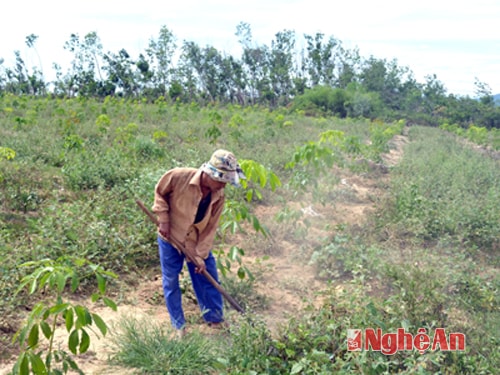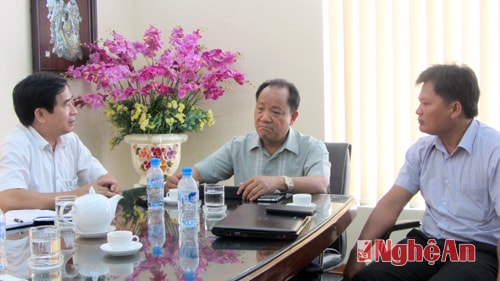Lesson 3: Be persistent with rubber trees
(Baonghean) - In addition to difficulties in capital and land, natural disasters and market fluctuations are creating concerns and doubts for rubber development, especially in the Central provinces. To contribute to explaining these issues, Nghe An Newspaper reporters went to Quang Binh, where storm No. 10 in 2013 destroyed more than 12,000 hectares of rubber, and also met and discussed with former Deputy Minister of Agriculture and Rural Development Ho Xuan Hung, former Chairman of Nghe An Provincial People's Committee, who is very passionate about Nghe An rubber...
Quang Binh is determined with rubber trees.
Up to now, along dozens of kilometers of Ho Chi Minh road, the shadow of storm No. 10 in 2013 is still imprinted by the traces of rubber trees falling in large numbers in the gardens. Talking to many rubber growers in Quang Binh, they said they were very saddened by this natural disaster, however, they still continue to consider rubber as the main crop to develop their family economy.
Mr. Luu Anh Dung, a citizen of Viet Trung Town, has 5 hectares of rubber, of which 2.5 hectares are in business age, which were wiped out by the storm. After the storm, he cut down the rubber trees to plant cassava, but "it was only to get through the immediate period". Talking, Mr. Dung said: "In Quang Binh, if there is no storm, planting rubber is the most suitable. I do not dare to take the risk but am thinking of 2 directions for production on my land. Or research to find a suitable crop that is economically effective. Or choose a new rubber tree variety, learn science and technology to continue cultivating...".
 |
| Mr. Tran Van Luong (left) introduces rubber trees planted nearly a year ago in Quang Binh. |
Unlike Mr. Luu Anh Dung, Mr. Tran Van Luong's family (Viet Trung Town) replanted 8 hectares of rubber after his and his 4 children's nearly 30-hectare rubber garden was destroyed by a storm. On the newly planted rubber land, Mr. Luong said he chose high-quality rubber varieties that are "resistant" to natural disasters. When planting, he carefully calculated how to place the roots so that the rubber trees can create roots that cling deep into the soil. In addition, he intercropped with cassava, corn, peanuts... to "take short-term to support long-term, and have more funds to pay workers' salaries". Mr. Luong confided: "My life has been attached to rubber trees for decades. The economy also originated from that, so I understand the value of rubber trees and am determined to replant them. Some people say I'm "crazy", but I think, on this land there can be no more suitable crop...".
We went to Hoa Trach commune, Bo Trach district, where 800 out of 1,200 households in the whole commune are engaged in small rubber plantations. According to Mr. Nguyen Thanh Binh - Vice Chairman of the Commune People's Committee, the natural land area of Hoa Trach commune is 2,400 hectares, of which 1,200 hectares are planted with rubber. For many years, rubber has been the main economic crop, bringing high income to the people. After the storm, many people were hesitant to replant, but many people are determined to replant. The viewpoint of Hoa Trach commune is to encourage people to continue to stick with rubber trees. Mr. Nguyen Thanh Binh affirmed: "My family also has 1 hectare of rubber for business and it was all damaged after the storm. Now, I am planning to replant the land for new planting...".
 |
| New rubber plantation of Viet Trung Rubber Company (Quang Binh). |
Quang Binh has many enterprises investing in rubber production and trading, of which Viet Trung Rubber Company is the unit with the largest area (3,000 hectares, of which 2,000 hectares are rubber for business, 1,000 hectares are in the construction period). According to Mr. Nguyen Xuan Dien - Head of the company's Organization Department, storm No. 10 dealt a heavy blow, causing most of the company's rubber area to be damaged. However, the company is still determined to rebuild the rubber garden. "In the 2014 plan, we planted about 400 hectares, and have now planted 70 hectares..." - Mr. Dien said. Also at Viet Trung Rubber Company, we met engineer Uong Van Hien - Head of the company's Technical Department, a fellow Nghe An native (Mr. Hien is from Hung Loc commune, Vinh city). Mr. Hien said: After storm No. 10, many leaders of Quang Binh province wondered whether they should continue to stick with rubber trees. The province and Hue University of Agriculture organized a workshop to find solutions to cope with natural disasters. I also attended and gave a speech at the workshop...". Mr. Hien showed us his speech, where he analyzed quite carefully the economic efficiency of rubber trees, natural conditions, and climate of Quang Binh province. From there, he analyzed the necessity of selecting varieties, soil, and planning rubber growing areas. In addition, he analyzed plot design techniques, planting density, soil preparation techniques, planting techniques; methods of care, fertilization, canopy creation, and exploitation and care regimes for commercial rubber gardens. Mr. Hien confided: The company used to bring coffee and pepper varieties... to plant, but their economic value was far lower than that of rubber trees. Therefore, we were determined to invest in new planting...".
According to the report of the Department of Agriculture and Rural Development of Quang Binh, in 2013, the total damaged rubber area was 12,174 ha/18,220 ha, of which the most damaged was commercial rubber. After reviewing and accurately assessing the damage, the Department of Agriculture and Rural Development of Quang Binh issued a document guiding methods to restore rubber gardens; reorienting new planting; in addition, providing solutions and recommendations... Of which, it is worth noting that the State should soon consider having a policy on insurance for rubber trees so that when there are natural disasters, people will suffer less economic losses; the Vietnam Rubber Industry Group needs to continue research to introduce new varieties and the most suitable technical process for rubber trees in the North Central region in general and the characteristics of Quang Binh province in particular; Propose that the Provincial People's Committee direct local banks to have policies to postpone, postpone, and cancel debts and provide loans with preferential interest rates with a period of 6-7 years to pay principal and interest so that businesses and households can continue to plant new trees and restore damaged rubber areas...
The right direction, but... too slow
Formerly the Chairman of the People's Committee of Nghe An province, the former Deputy Minister of Agriculture and Rural Development and Chairman of the Board of Directors of the Vietnam Rubber Group, Mr. Ho Xuan Hung is very concerned about the development of rubber in Nghe An. He said that in recent years, due to severe natural disasters in the Central region, in addition to the instability of the market, it has created anxiety among the people and local leaders about issues related to rubber trees. Therefore, in some localities, there has been a situation of people cutting down rubber trees. However, in recent years, Nghe An has been right in sticking with rubber trees. And Nghe An has chosen the right land to plan rubber planting; at the same time, has chosen the right partner (Vietnam Rubber Group) to develop large-scale rubber plantations.
| RELATED NEWS |
|---|
 |
| Nghe An Newspaper reporter interviewed comrade Ho Xuan Hung. |
Regarding the market issue, Mr. Ho Xuan Hung analyzed: Not every country can grow rubber, while synthetic rubber from petroleum is increasingly scarce. Many countries that can grow rubber trees no longer have acreage, so they aim to intensify cultivation and increase productivity. Vietnam has the conditions to expand the area of new rubber plantations, if scientific advances are well applied, high-quality varieties are selected, that is the advantage of our country. The market economy always follows a sine curve, at this time a decline is also a normal rule. There are cases of people destroying rubber trees because of low prices, however, that is only an isolated phenomenon, concentrated in small rubber households. According to statistics of the Ministry of Agriculture and Rural Development, the total rubber area in the country is over 900,000 hectares, but the area that has been cut down is only over 3,000 hectares. And, for the Vietnam Rubber Group, it is affirmed that there is no problem with the market impacts because the Group has signed contracts with partners from previous years, which are still valid for several more years. In addition, the Government has also directed the Vietnam Rubber Group to diversify the market, research cooperation with large corporations to use raw materials to produce final products...
Evaluating the results of rubber development in Nghe An in recent years, Mr. Ho Xuan Hung compared: With the same goal of developing rubber at a time, the northern provinces have had larger rubber areas than Nghe An, and have entered the business period. He said: Nghe An has the right direction but the implementation is too slow... Asking the question: Is it true that Nghe An province has not paid due attention to rubber development? He replied: On this issue, journalists should find the answer themselves...
"To minimize the damage caused by storms, we must build windbreak belts, and we have chosen GT1 rubber variety (a hard-stemmed rubber variety that produces little latex) to do this. In addition, between rubber plots, it is necessary to design roads to serve production and combine them with ventilation strips; properly prune rubber branches, not letting the rubber canopy become too heavy... We have chosen rubber varieties RRIM 600, RRIM 712, RRIC 100, RRIC 121, PB 260 to carry out new planting. These are rubber varieties with good productivity, strong trunks, developed root systems, balanced canopy and high disease resistance... (Engineer Uong Van Hien - Head of Technical Department, Viet Trung Rubber Company) |
PV Group(continued)


